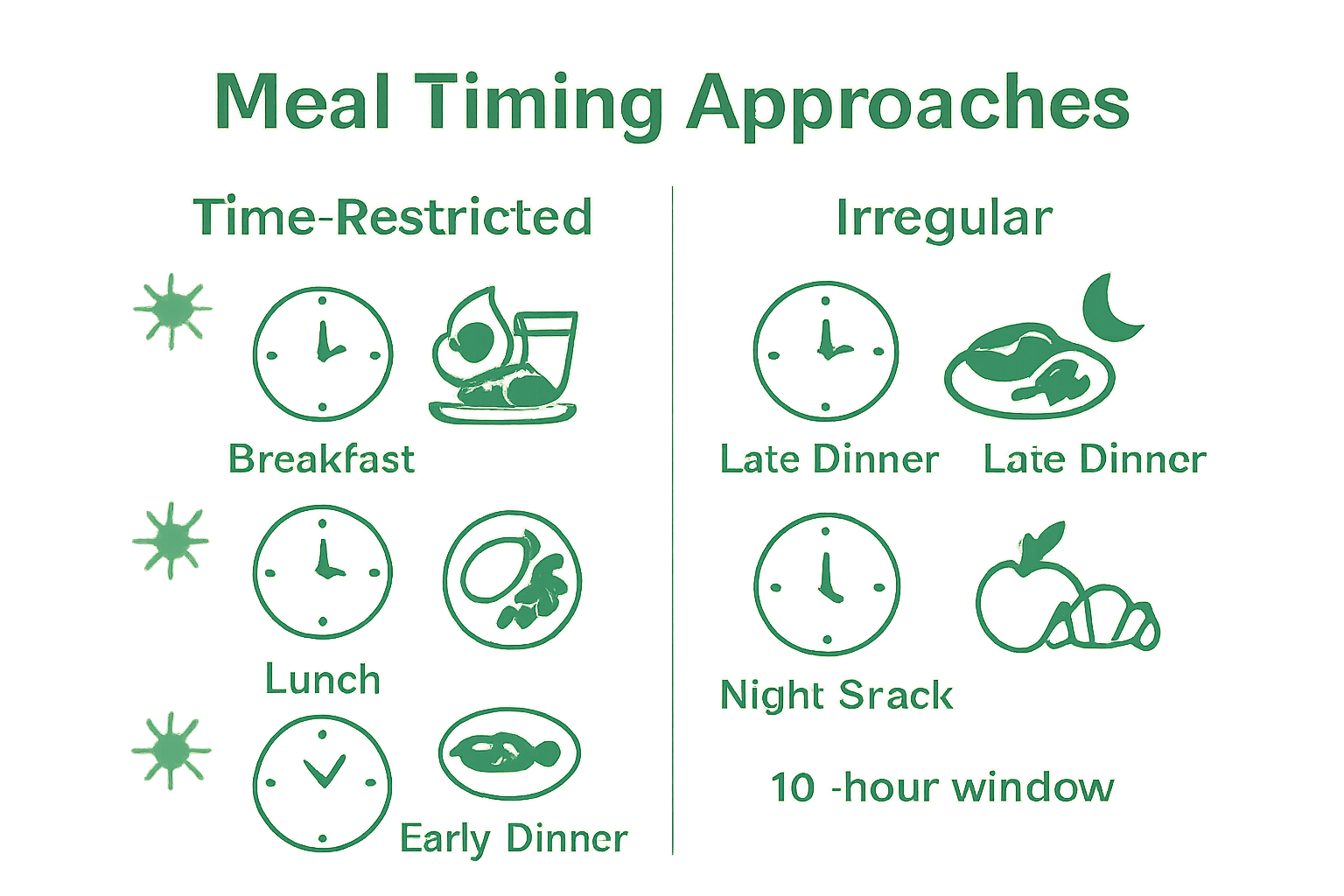Meal timing sounds simple and most people just focus on calorie counts or what is on their plate. But here is a surprising fact. Research shows that the timing of your meals can impact weight loss just as much as what you eat. Late night snacks might be setting you back more than you think and eating earlier could make your metabolism work harder for you.
Table of Contents
- What Is Meal Timing And Why Is It Important For Weight Loss?
- The Science Behind Meal Timing: How It Affects Metabolism
- Different Meal Timing Approaches And Their Impact On Weight Loss
- Key Concepts And Factors Influencing Meal Timing Success
- Real-World Applications: Meal Timing In Everyday Life
Quick Summary
| Takeaway | Explanation |
|---|---|
| Timing meals aligns with metabolism | Eating at consistent times syncs with your body’s biological clock, optimizing metabolic efficiency for weight management. |
| Larger meals earlier support fat burning | Consuming nutrient-dense meals in the morning and lighter meals in the evening can enhance energy utilization throughout the day. |
| Individual differences matter | Each person’s metabolism responds uniquely to meal timing, making personalized strategies essential for effective weight management. |
| Flexibility is key in real life | Successful meal timing requires adaptable methods that fit your daily routines, schedules, and personal preferences. |
| Time-restricted eating enhances insulin sensitivity | Limiting your eating window to 8-10 hours can improve metabolic efficiency and support weight loss efforts. |
What is Meal Timing and Why Is It Important for Weight Loss?
Meal timing represents a strategic approach to organizing food consumption throughout the day, focusing on when you eat in addition to what you eat. Unlike traditional diet perspectives that solely concentrate on caloric intake, meal timing explores how the biological clock and metabolic processes interact with nutrient consumption to potentially influence weight management.
Understanding the Metabolic Impact
Researchers have discovered that our bodies respond differently to food based on the time of day. Studies from the National Institutes of Health suggest that irregular eating patterns can significantly disrupt metabolic functions and potentially increase obesity risk. The human metabolism operates on a complex circadian rhythm, meaning certain times of day may be more conducive to efficient energy processing and fat burning.
Key metabolic considerations include:
- Insulin sensitivity fluctuates throughout the day
- Hormonal responses vary depending on meal timing
- Metabolic rate can be influenced by consistent eating schedules
Circadian Rhythm and Nutritional Synchronization
Our internal biological clock plays a crucial role in how we process nutrients. Consuming meals at consistent times can help synchronize metabolic processes, potentially improving energy utilization and weight management. Read more about sustainable weight loss strategies to complement your meal timing approach.
The fundamental premise of meal timing for weight loss centers on understanding how strategic food consumption can optimize metabolic efficiency. By aligning nutritional intake with the body’s natural rhythms, individuals may enhance their ability to burn calories, regulate hunger signals, and maintain a more balanced energy expenditure throughout the day.
The Science Behind Meal Timing: How It Affects Metabolism
Metabolism represents a complex network of biochemical processes that convert food into energy, and meal timing plays a critical role in optimizing these intricate physiological mechanisms.
Understanding how nutrition interacts with our metabolic system reveals fascinating insights into weight management and overall health.
Hormonal Dynamics and Energy Regulation
Research from the National Institutes of Health demonstrates that meal timing significantly influences hormonal responses that regulate metabolism. Hormones like insulin, cortisol, and growth hormone fluctuate throughout the day, creating metabolic windows where the body processes nutrients more efficiently.
Key hormonal interactions include:
- Insulin sensitivity peaks during morning and midday hours
- Cortisol levels naturally rise in the morning, supporting metabolic activity
- Growth hormone secretion varies with meal frequency and timing
Circadian Metabolic Rhythms
Our internal biological clock governs metabolic processes through complex circadian rhythms. Explore more about metabolic health to gain deeper insights into these intricate biological mechanisms. Different times of day can trigger varying metabolic responses, with morning metabolism typically being more active and responsive compared to evening metabolic rates.
The human body processes nutrients most effectively when meals align with natural circadian rhythms. Consuming larger, more nutrient dense meals earlier in the day and lighter meals in the evening can potentially enhance metabolic efficiency, supporting more effective weight management and energy utilization.
Different Meal Timing Approaches and Their Impact on Weight Loss
Meal timing strategies offer diverse approaches to optimize metabolic performance and support weight management goals. Understanding these varied techniques allows individuals to select methods that align with their unique physiological needs and lifestyle preferences.
Time-Restricted Eating
Research from nutritional sciences reveals time-restricted eating (TRE) as a promising meal timing approach. TRE involves consuming all daily calories within a specific, limited time window, typically ranging from 8 to 10 hours, which can potentially enhance metabolic efficiency and support weight loss efforts.
Key characteristics of time-restricted eating include:
- Restricting food intake to a consistent daily time frame
- Allowing extended overnight fasting periods
- Potentially improving insulin sensitivity
- Supporting natural circadian rhythm synchronization
Intermittent Fasting Variations
Intermittent fasting encompasses multiple strategies that alternate between eating and fasting periods. Learn more about sustainable weight loss strategies to complement these approaches. Popular variations include the 16/8 method (16 hours fasting, 8 hours eating), alternate-day fasting, and the 5:2 diet, each offering unique metabolic benefits and potential weight management advantages.
These approaches differ fundamentally in their implementation but share core principles of strategic nutrient timing and metabolic manipulation.
To clarify the similarities and differences among popular meal timing approaches discussed, the following comparison table summarizes key features, implementation, and benefits.
| Approach | Key Features | Typical Eating/Fasting Windows | Potential Benefits |
|---|---|---|---|
| Time-Restricted Eating | Eat within a specific daily window | 8-10 hours eating / 14-16 fasting | Enhances metabolic efficiency, |
| improves insulin sensitivity | |||
| 16/8 Intermittent Fasting | 16 hours fasting, 8 hours eating | 8 hours eating / 16 fasting | Supports weight loss, may reduce appetite |
| Alternate-Day Fasting | Alternate fasting and regular days | Fasting every other day | Promotes fat burning, metabolic flexibility |
| 5:2 Diet | Eat normally 5 days, restrict calories 2 | 5 days unrestricted/ | |
| 2 days restricted | May boost metabolism, flexible routine |

Key Concepts and Factors Influencing Meal Timing Success
Successful meal timing strategies extend beyond simple scheduling, requiring a nuanced understanding of individual physiological responses, lifestyle factors, and metabolic variability.
To help you understand what influences an individuals response to meal timing, here is a table summarizing the key factors mentioned in the article and their effects on metabolic variability.
| Factor | Description | Impact on Meal Timing Success |
|---|---|---|
| Genetic Predispositions | Inherited traits affecting metabolism and chronotype | Alters optimal meal timing windows |
| Sleep Quality and Duration | Quality and amount of rest per night | Affects hormonal balance, energy utilization |
| Physical Activity Levels | Regular exercise frequency and intensity | Increases metabolic rate, shapes energy needs |
| Stress Management | Ability to manage psychological and physical stress | Impacts hormonal balance, contributes to variability |
| Existing Metabolic Health | Conditions like diabetes or insulin resistance | Requires tailored meal timing for safety |
| Achieving optimal results demands a holistic approach that considers multiple interconnected elements. |
Individual Metabolic Variability
Research on circadian rhythms reveals profound individual differences in metabolic responses, highlighting the importance of personalized meal timing approaches. Each person’s unique chronotype, hormonal profile, and lifestyle significantly influence how effectively they process nutrients and regulate energy expenditure.
Key factors affecting individual metabolic responses include:
- Genetic predispositions
- Sleep quality and duration
- Physical activity levels
- Stress management
- Existing metabolic health conditions
Lifestyle Integration and Sustainability
Explore practical meal planning strategies to support your meal timing approach. Successful implementation relies not just on scientific understanding, but on an individual’s ability to integrate these strategies into their daily routine. Sustainable meal timing requires flexibility, consistent planning, and alignment with personal work schedules, exercise routines, and social commitments.
Ultimately, meal timing success emerges from a delicate balance between scientific principles and personal adaptability. Understanding one’s unique metabolic landscape allows for more targeted, effective approaches to nutrient consumption and weight management.
Real-World Applications: Meal Timing in Everyday Life
Translating scientific insights about meal timing into practical daily strategies requires understanding how theoretical principles intersect with individual lifestyle constraints. Successful implementation demands flexibility, realistic expectations, and personalized approaches that accommodate diverse work schedules, family dynamics, and personal preferences.
Workplace and Professional Environments
Research on dietary adaptation demonstrates that meal timing strategies can be effectively integrated into professional settings. Professionals with varying schedules must develop adaptive approaches that maintain metabolic consistency while navigating demanding work environments.
Key workplace meal timing considerations include:
- Planning nutrient-dense meals during peak energy windows
- Preparing portable, easily consumable meals
- Managing lunch breaks strategically
- Maintaining consistent meal intervals
- Avoiding prolonged fasting periods during work hours
Practical Integration Strategies
Check out meal preparation tips for busy lifestyles to support your meal timing goals. Successful real-world application involves creating structured yet flexible eating patterns that align with individual circadian rhythms and lifestyle demands. This might involve batch cooking, strategic meal prepping, or utilizing technological tools to track and optimize nutritional intake.
Ultimately, effective meal timing transcends rigid scientific models, requiring a personalized approach that balances metabolic science with practical daily realities. The most successful strategies emerge from understanding individual physiological responses and crafting adaptable nutritional frameworks that support long-term health and weight management goals.
Turn Science-Backed Meal Timing Into Real Results with Dietium
If you have ever struggled to transform complex meal timing theories into daily habits that actually help with weight loss, you are not alone. The article highlights the challenge of syncing your eating schedule with your body’s natural rhythm, especially while juggling work, family, and changing routines. Many find it tough to build meal plans that fit their unique metabolic needs. Small daily missteps can lead to stalled progress, frustration, and confusion about what works best for your health goals.
Ready to take the guesswork out of meal timing? Let Recipians by Dietium turn proven nutritional science into actionable, personal strategies. Our platform offers you:
- Custom meal plans tailored to your circadian rhythm
- Smart tools that track your calories, BMI, and metabolic rates
- Practical recipes and fitness routines to fit your lifestyle
- Easy integration across devices for constant support
Explore how Recipians uses advanced AI to align your nutrition with your daily routine. Unlock your own path to successful weight management today by visiting Dietium.com. Make your next meal a step toward real results.
Frequently Asked Questions
What is meal timing and how does it affect weight loss?
Meal timing is a strategic approach to organizing food consumption throughout the day, focusing on when you eat in addition to what you eat. It can enhance metabolic efficiency and support weight management by aligning food intake with the body’s natural circadian rhythms.
How does meal timing impact metabolism?
Meal timing can influence metabolic processes by affecting hormonal responses and insulin sensitivity. For instance, consuming larger meals earlier in the day when insulin sensitivity is higher can promote better energy utilization and fat burning.
What are some effective meal timing strategies for weight loss?
Effective meal timing strategies include time-restricted eating, which limits calorie intake to a specific time window, and various forms of intermittent fasting. These methods help optimize metabolic performance and can support weight management goals.
How do individual factors influence the success of meal timing?
Successful meal timing extends beyond scheduling, as individual metabolic responses vary based on factors like genetics, sleep quality, physical activity, and stress management. Tailoring meal timing strategies to personal needs can enhance their effectiveness.





